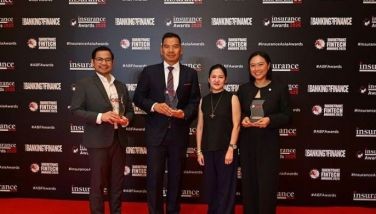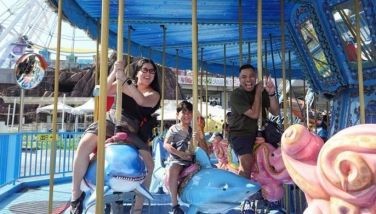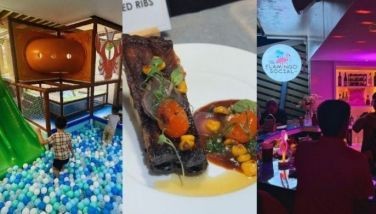Miguel Pastor, architect of desire
MANILA, Philippines - South America,” Miguel Pastor says instantly when asked about his favorite destination. “The people are so warm and beautiful.” His worst trip? “No trip is really ever bad,” he says. “You always learn something — even from the bad ones.”
Pastor, an architect for Suyen Corp. and the man responsible for the interiors and window display of Bench stores, is a frequent traveler. With his partner Ben Chan, they scour the globe for exotic hotspots, like Havana and Reykjavik, for example, as well as visit old haunts like London and New York.
All these places serve as Pastor’s muse — they get his creative juices flowing. “The more you know about people, the better you understand humankind,” he says. “The better you understand humankind, the more you become inspired by their ways and ideas. This gives you a new perspective on looking at things that ignites the creativity in you.”
STAR plumbs through the architect’s dream destinations, his most inspiring journeys and the makings of a stylish travel wardrobe.
PHILIPPINE STAR: You designed Felix Restaurant in Greenbelt 5, Market on the 5th at St. Luke’s Global City, and are currently doing a new Chinese restaurant (Pao Pao). Is there a fantasy restaurant design on your drawing board that you are aching to build?
MIGUEL PASTOR: Creating a restaurant is like visualizing a stage set for an epicurean feast. It gives me some unexplainable thrill whenever I experience dining in a new restaurant. It’s synonymous to exploring a new territory and the innate feeling to discover the tangible and intangible details takes over. Though the food is the reason why you hang out in your favorite restaurant, having a good interior sets the mood, pace and degree of comfort that rules your senses and could make you decide whether you would want to stay for a while or lounge for the next two hours or so.
I haven’t done many restaurants, so I consider every project and opportunity to design one as a bit of a fantasy. Since all the three restaurants I’ve done are located in the city, one that is built in a resort (beach or mountainside) would be a good change.
Do you think there is such a thing as Filipino design?
Filipino designs have always been derivative. Nonetheless, Filipino designers have a knack for spicing up their derivative designs with Filipino elements. Thus, Filipino Art Nouveau by Tampinco and Alvero was replete with indigenous flora such as anahaw and banana leaves; while Filipino Bauhaus structures — while streamlined and austere architecturally — cannot escape the Pinoy’s penchant for horror vacui: grillwork, terrazzo flooring, intricate woodwork and parquet flooring, stained-glass windows, and murals by Manansala and Botong Francisco. While, strictly speaking, there is no Filipino design per se, Filipino designers have over the years created a unique design vocabulary that is truly theirs.
Which places do you most enjoy window shopping — looking at store windows and retail displays? Any favorite memorable windows you’ve seen lately?
If you want to see hip, modern window displays, head to Barneys New York. They are always humorous, chic, as well as creative and interesting. A store where window displays is a shopping event all by itself.
On 5th Avenue, Bergdorf Goodman’s window remains an enduring art form providing rare views through the glass into fantastic realms of dream and fantasy. One of the most memorable windows I’ve encountered was a Holiday 2009 “Compendium of Curiosities” window display that featured Alexander McQueen wherein the entire set was made from paper, including the architectural trimmings and furniture. Their windows continue to astonish and delight all who flock to them for the traditional annual Christmas displays.
In designing the Bench group of stores, what factors/inspirations are foremost in your mind?
There are many things to consider when designing a retail shop. It is of utmost importance that you are able to satisfy the client’s demands in terms of fulfilling the space requirements. Thus, a good design is being able to come up with a plan that maximizes the value of the space.
For retail stores like Bench, I always look at it from the point of view of a shopper. The plan should be easy for them to move around with total ease. There should be a logical order in the way the merchandise is displayed in the store.
As a designer, a lot of things are always brewing in your mind. In between creating order in the space, you are also rendering a lot of ideas from inspirations you draw in your mind based on your personal experiences and preferred aesthetics. In the end, you come up with a new logical design and hope it satisfies the vision of your client.
What was the inspiration for your latest project?
Market at the 5th in St. Luke’s Medical Center in Bonifacio is one of the latest dining places in chef Florabel Co’s roster of dining places for comfort Filipino-Chinese food. She asked me to develop a “homey,” no-frills comfort food dining place that should exude a certain warmth set against the antiseptic setting of a modern hospital. We weren’t interested in creating a high-class dining space, but rather a place where everyone could go to enjoy all-day dining. My inspiration for this is the Food Emporium at the Queensborough Bridge in Manhattan.
As an architect/designer of spaces, who are the architects/designers that you look up to?
The Brazilian brothers Fernando and Humberto Campana who are able to draw inspiration from street life and carnival culture combine objects, such as scraps of wood and fabric off-cuts with advanced technologies to create a vibrant, energetic approach in design.
The first woman to win the Pritzker Prize for Architecture, Zaha Hadid, who has defined a radically new approach to architecture by creating buildings with multiple perspective points and fragmented geometry to evoke the chaos of modern life.
Hussein Chalayan is one of the most visionary designers working in fashion today. His pioneering work is motivated by ideas drawn from disciplines not associated with fashion, crossing between anthropology, history, science, philosophy and technology.
Isamu Noguchi’s sculptural sensibility to everything he created: lighting, furniture, gardens and stage sets.
Sir Norman Foster, an architectural phenomenon who is responsible for a dozen or more of the key buildings of the last 30 years, but also as the founder of perhaps the most successful architectural practice of modern times.
Terence Conran, founder of Habitat, the furniture company that he grew from a single, very high-profile outlet in London, to an international chain. He has had more impact than any other designer of his generation on everyday life by taking Britain out of the gloom of post war-austerity into a vision of what the domestic world could be like.
What’s your favorite structure/building in the world?
Antonio Gaudi’s Casa Mila, a surrealist apartment block in the center of Barcelona. This truly strange building is a stone palazzo into, which Gaudi has poured sinuous apartments that are like nothing else you’ll see on earth.
“The straight line belongs to Man. The curved line belongs to God,” says Gaudi and he practised what he preached. Finding a straight line inside or outside Casa Mila is near impossibility.
Outside, the block appears to stand on the legs of stone elephants, while balconies and window moldings jut out like strange lips or eyebrows of giants you would expect to meet in the grotesque gardens of Baroque Italy.
The roof garden is like a Dali painting come to life. Casa Mila has been used by many filmmakers. It remains utterly surreal and yet it is no gimcrack design. The building is thought through as all of a piece. If it chose to walk off by itself one night to live in another city, it would have to come back: only in Barcelona can architecture of this topsy-turvy character make sense.
How does good architecture make you feel?
I’d always felt some kind of excitement as a kid as I began to discover the architecture of my century after childhood years spent in the streets of New Manila where I grew up. I would always find myself wandering around the neighborhood, viewing mansions like Villa Caridad, the Felix Manalo house in the compound where I grew up, and other fairly modern structures built in the ‘50s by great Filipino architects like Pablo Antonio, Jose Zaragoza and Leandro Locsin.
As a student of architecture then, I would find myself browsing through books on architecture, dreaming of what the buildings were really like and thinking the rational behind the design. I admire the genius like Le Corbusier and Louis Kahn who uses concrete, or how the play of sunlight on steel beams or weather-boarded concrete transforms what you had imagined to be a brute of a building into an unexpected beauty.
What are the elements of an amazing structure?
A simply designed building combined with good engineering defines an amazing structure for me. Buildings are like poetry. A building is a living sculpture that converses with everyone.
You’ve traveled across the globe. Is there a favorite location you always want to come back to?
I would definitely like to go back to the lively, colorful city of Havana. This city alone is worth the trip to Cuba. This is a place that is full of bustle and entertainment with some splendid architectural gems from Neo Moorish colonial period and beyond. A place of music and color that, despite severe economic difficulties, has held on to its unique identity.
A must-do is a stroll on the busy seafront promenade of Malecon leading to the historic quarters, from the Colonial center to the skyscrapers of Vedado. I miss walking through the historic Havana Vieja, the largest colonial center in Latin America, which is now a part of the cultural heritage of humanity by UNESCO. The district’s splendor is the Hispanic-Andalusian architecture. Time seems to stand still here but it does not give the impression of being a museum.
In general, Cubans are outgoing, talkative and sociable. The doors of their houses are always open, a glass of rum or a cup of coffee is there for anyone who passes by to say hello or chat. There is no clear-cut boundary between home and the street.
Music is everywhere and is the soul of the island. Melodic thanks to the Spanish to the Spanish heritage, and dynamic due to the hypnotizing rhythm of Afro-Cuban percussion, religious and passionate at the same time, music is a vital part of daily life, like dance.
Images of Cuba show hot sun and fields of sugar cane, tall palm trees and deep, clear blue sea. Cuba is indeed all these things, but it is also a country with a deep-rooted, complex culture in which old traditions and new intellectual developments co-exist.
Favorite hotel?
With breathtaking views across Ipanema Beach, The Fasano Hotel Rio de Janeiro is the ultimate in Brazilian decadence. Its understated façade masks a wealth of quirky style interiors. The reception desk is carved from a huge tree trunk. Each room is equipped with individual balconies that are separated by mirror screens, which give an added level of privacy. Inside the room, the Philippe Starck touches come to the fore, such as the curved light fittings, the leather chairs and the use of luxury materials such as marble and granite for surfaces. The hotel promises signed pieces from the ‘50s and ‘60s and this is evident in the leather chairs and the Dali-esque mirrors. The hotel’s crowning glory is the rooftop pool and bar. The vista here is stunning, looking along the whole Ipanema beach and round to the Cristo statue on Corcovado behind you.
Favorite restaurant abroad?
I always get the urge for ramen whenever I’m in a late-night outing in Tokyo especially on a cold autumn weather. The best place to go is Ippudo Ramen. There are a number of outlets throughout Tokyo, but I like the one in Roppongi best. It serves Hakata-style tonkatsu ramen (pork stock). The noodles can be ordered to your preferred consistency (I like them slightly softer). I always opt for extra green onions and grind lots of fresh sesame into my noodles before I go crazy. The Hakata gyoza also compliments the noodles quite well. A truly authentic ramen experience!
In New York, Balthazar’s on Spring Street is one of my favorite places to eat in the whole city. The bread is something I dream about all the time. The french fries with mayonnaise, scrambled eggs vol au vent with asparagus, burger, steak frites, trout salad, French onion soup, they’re all delicious. The profiteroles and lemon tart are also very delicious. I have been going to Balthazar for years and have never been disappointed. The service is always amazing even with the incredibly hectic environment.
Favorite travel buddy?
Ben Chan.
Favorite memory from your journeys?
One of my unexpected journeys was a visit to Reykjavik about five years ago. I never thought it is a country where you can see and do things you can’t elsewhere. I had a completely different vision of what Iceland could offer travelers. It’s hard to think of another place where you can whale watch, climb a glacier and take a dip in the Blue Lagoon, a geothermal spa where guests relax in a warm geothermal seawater all in the same day! The country has many activities for all ages and abilities and you can challenge yourself as much or as little as you want. There are always specially trained people on hand to help you if you are a beginner at things like sea kayaking or white water rafting. You can even take a day trip to Greenland.
Reykjavik is a city where you’ll feel safe to walk the streets. With its colorful houses, friendly people, it’s like being in a big village. But this “village” has a multitude of cultural venues, gourmet restaurants, and stores. It also has the modern conveniences, services and quality of living you would expect from a world-class city. I would always want to go back to Iceland anytime.
Worst travel experience?
Only last April, we got stranded in Milan on our trip to the Salon de Mobile as Iceland’s Eyjafjallajökull volcano continued to erupt, creating an enormous ash plume that has caused major problems in the travel industry. We had to find a way to Rome as all airports in Europe were closed except for Barcelona, Athens and Rome. It was like a scene from the TV series, The Amazing Race, as thousands of passengers flocked to the nearest train station trying to book a seat to get back home. We were one of the lucky ones as our Milan accommodation (Principe de Savoia) was just across the Grand Central Milan. Our concierge secured for us train tickets, and we were able to book a hotel in Rome easily. The only downside was we had to purchase a new plane ticket.
What are your three travel essentials?
A guidebook gives an overview of what your destination has to offer considering you only have a few days to explore.
Mac’s newly launched iPad is my latest discovery. I’ll speak for myself, and you have to realize that I have not tried every possible application on this gadget, but in my case it is great for Web browsing and e-mail. The battery lasts much longer, it’s lighter and it is “instant-on” — no boot, no shutdown.
Movie playback is something that recent net books can deal with, but most of them will run out of battery after three to six hours while the iPad can go on for 10 hours.
Most importantly, it contains the iBook feature that makes use of the interface of the Apple book reader. It’s simple and readable, and most importantly, most books (if not all) come with a free sample.
My Nikon SLR D40 is a compact digital SLR that is great to carry for my travels. Camera performance is superb. Flip the power switch and the D40 is ready to go. Focusing times are very good, and low-light focusing was excellent thanks to a powerful AF-assist lamp. Photo quality is also very good. Nikon has tweaked the camera to produce what I’d call “consumer friendly” photos, with high color saturation and higher sharpness than on more expensive D-SLRs.
Do you dress differently when you travel?
I always try to travel light. I usually bring the usual basic clothing that includes collared tees in neutral colors, black and gray denim jeans, a cotton pullover for layering at night when it gets cooler, a light hooded jacket for daywear and a travel coat I can stuff in my hand carry bag.
How do your travels influence your work?
I always believe that the experience derived from your travels could become one of your best teachers in life. We learn so much from things we see and experience every time we visit a new place. We all see things variably depending on how you embrace and open up your senses to your surroundings. Say the sound of NYC’s fire trucks and subway trains may be annoying to some, but it may inspire others to create music. The same way as when I always find inspiration whenever I see the breathtaking mountains of Queenstown, the blue-green waters in the lake in the Jiuzhaigou national park, the majestic waterfalls of Iguazu, and natural elements that inspires peace and serenity. All these experiences inspire me to a certain degree of creativity in my craft.
How does traveling inspire you and make you more creative?
Travel is perhaps the best way to experience culture and social life of other people. Your mind opens up and becomes more accepting of various beliefs. The more you know about people, the better you understand humankind. The better you understand humankind, the more you become inspired by their ways and ideas. This gives you a new perspective on looking at things that ignites the creativity in you.
In your opinion, what defines a stylish man?
A stylish man is someone who is able to dress himself well according to the occasion. Dressing well is a kind of good manners, if you ask me. When you’re standing in a room, your effect is the same as, say, a piece of furniture. You’re part of someone’s view. You’re part of that world and you should dress well. It’s a show of respect to try to put on your best face and look as good as you can.
It’s a myth that great style requires constant reinvention. Personal style, unlike fashion, derives its power from consistency. Think of the clothes that you’ve returned throughout your life. Most likely, certain things keep reappearing. Maybe it’s a preference for monochrome, or it’s a confident use of color. Or it could simply be the fact that you’ve always felt more comfortable in wearing denim over slacks.
How would you classify your personal style?
When it comes to my personal style, like Mies van der Rohe, I believe in the saying “Less is more.” This also reflects how I see the world. This kind of sartorial austerity doesn’t mean I can’t wear patterns. It simply requires subtlety in my choice of clothes and a sharp eye for details. It’s about removing unnecessary detail and finding the proportions that work best for me.
What are the elements of the perfect wardrobe?
The most vital and stylish possessions a man can own are the ones that help him enjoy life. A man’s closet has to be flexible and game for anything. Clothes don’t make a man well dressed. Elegance is a function of your personality.
A sports jacket is a pivotal link between the worlds of casual and formal attire. You can play around with proportions all you want to create a sharp, modern silhouette. The new austerity in men’s fashion does not mean an absence of pattern. The rule is to keep it subtle and keep it simple.
A crisp white shirt is something you can never have too many of. I prefer a medium spread collar that sits high on the neck. You can never wear them too often.
A pinstripe shirt for everyday work wear is the simplest graphic choice. It exudes a hard-edged formality that shouts “business.”
The sexiest thing a man can wear is a nice pair of jeans. Nothing too light, and they shouldn’t be too tight or too loose. Flat front trousers are the ne plus ultra for modern men.
An elegant pair of shoes is also a must. Whether it’s a wingtip, Oxford, Blucher, Monk Strap or moccasin, the shoes should always appear clean and well maintained.
What’s the one thing a stylish dude should have?
A handcrafted stylish timepiece. A good watch can tell you the minute and the hour and get you through the day. A great one can tell the world a story and stay with you for life. When a man becomes a man and earns a man’s salary, he is naturally drawn to markers of his status. Invest in a watch that will last a lifetime and beyond. They only come from reputable watchmakers who themselves have withstood the test of time.
Best sartorial advice from your parents?
From my dad, he taught me to always look your best as it is important that you create a good impression on people. From my mom, she’s a practical dresser. She was not into expensive clothing, but rather more about creating a style that suits your personality.
Anyone you looked up to in fashion since you were a kid?
Warren Beatty. If Warren Beatty wore scuba flippers instead of shoes, we might consider copying. If he wore garbage bags instead of Oxfords, we might wake up and throw them on, too, because, you know, Warren did it. But inevitably we’d balk because, well, we’re not Warren Beatty. We don’t have that once-in-a-generation leading-man confidence, that hyper-evolved swagger, that “Me? Yeah, I know — I’m great looking” smile. In a sense, it’s never really mattered what Warren Beatty wore. Warren Beatty, shirt unbuttoned to his navel, silk scarf knotted around his neck, looked… manly. Beatty tuxedo-clad? Downright debonair. And from Splendor in the Grass onward, he’s always looked completely nonchalant, which isn’t to say he didn’t think about his sartorial choices.
Three things you own that defines your style?
A Tric-Trac Valextra bag. Tric-Trac is a bag to store keys, wallet, sunglasses and mobile phone — certainly very simple and equally elegant. Made of a steel frame to best protect objects within it, it has a revolutionary way of opening up like a box. It has a strap to hold against the back of your hand. Crafted by Valextra, a company that produces all-Italian handbags and luggage of great elegance and style.
Denim jeans is my everyday wear. I prefer the raw Japanese denim because of its crispness and medium density, it holds flat and steady the whole day.
Sneakers and rubber-sole shoes.
What do you never leave home without?
My Blackberry Bold 9700 is my compact office communicator that keeps me company all day as well as in my travels. It has great e-mail experience. With Office To Go, it is possible to open and edit Word, Excel and PowerPoint. Through Instant Messaging, I can exchange thoughts with my friends abroad at no added cost.
Item in your closet you cherish the most?
At the moment it’s the Moncler jacket I recently got in a Milan trip last April. I saw a lot of coats in the spring-summer 2010 collection, but the one that really caught my eye was this.
What do you wear every day?
I wear dark denim jeans, pinstriped work shirt, crisp white and a blue long-sleeved shirt for this year.
What would you never be caught dead in?
Sandals.
















